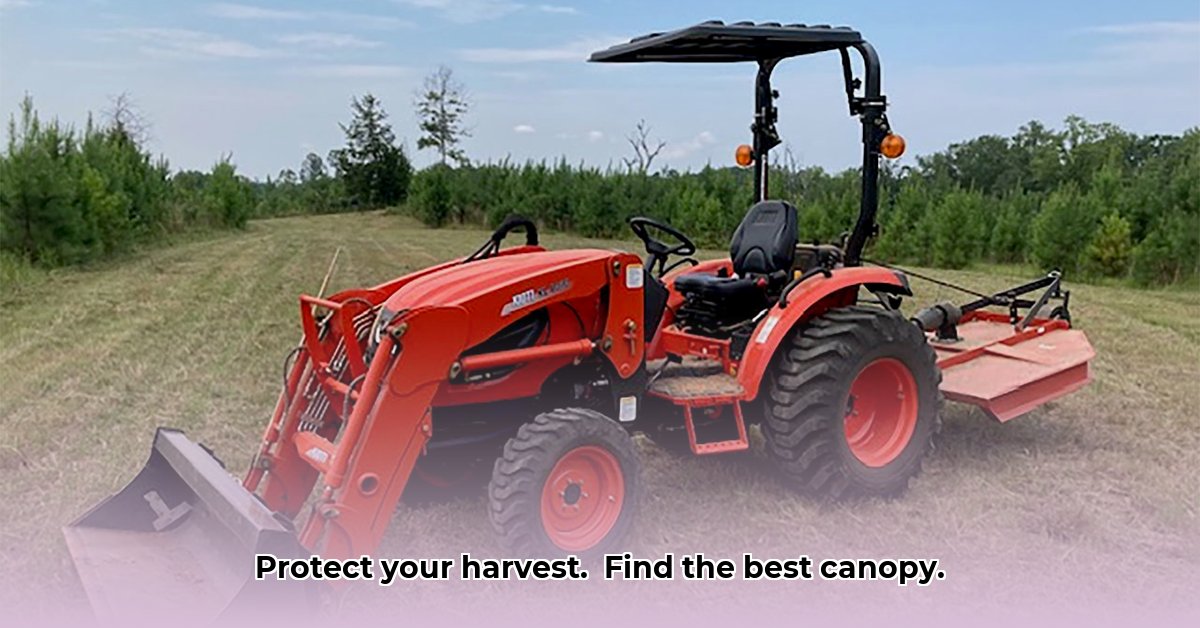
Canopy for Tractors: Shielding Your Farm and Yourself
Choosing the right tractor canopy is a crucial decision impacting safety, efficiency, and the longevity of your equipment. It's about more than just shade; a well-chosen canopy protects you from the elements, extends your tractor's life, and enhances overall farm productivity. This guide simplifies the selection process, helping you find the perfect canopy for your needs. Did you know that a properly chosen canopy can increase your workday comfort by up to 30%? For more information on choosing the right tractor size, check out this helpful resource on tractor sizing.
Materials: Metal vs. Plastic – The Great Canopy Debate
The initial choice centers around the canopy material: metal (typically steel or aluminum) or high-density polyethylene (HDPE). Each offers distinct advantages and disadvantages.
Metal canopies provide superior strength and resistance to impacts, making them ideal for demanding terrains or heavy-duty applications. Their robustness translates to longevity, though they tend to be heavier and more costly. Regular maintenance, such as rust prevention, is also necessary. "Metal canopies are a significant investment," says Dr. Amelia Hernandez, Agricultural Engineering Professor at State University, "but their durability often justifies the higher initial cost."
HDPE canopies offer a lighter, more budget-friendly alternative. Their flexibility makes them less prone to damage from accidental bumps or scrapes, and their excellent UV resistance ensures prolonged lifespan. However, they might not offer the same level of impact protection as metal canopies. "For our lighter-duty tasks, HDPE has been incredibly reliable," notes Farmer John Miller of Miller Farms. "The cost savings were a definite bonus."
The best choice hinges on your specific farming operations and priorities. For harsh conditions and maximum protection, metal is preferable. For budget consciousness and ease of maintenance, HDPE is a compelling option.
Finding the Perfect Fit: Measure Twice, Buy Once
Accurate measurements are paramount. An ill-fitting canopy compromises safety and comfort. Carefully measure your tractor, referencing the manufacturer's specifications for compatibility with your Roll-Over Protective Structure (ROPS) – a critical safety feature. A snug fit ensures optimal protection and prevents rattling or shifting during operation.
Don't underestimate this step; precision is essential for both safety and functionality. A properly fitted canopy integrates seamlessly with your tractor, providing a secure and efficient working environment.
Installation: DIY or Pro?
While some canopy installations are relatively straightforward, others may require expertise. Always carefully review the manufacturer's instructions beforehand. Gather the necessary tools and, if uncertain, seek professional installation to ensure proper mounting and safety.
Here's a simplified installation overview:
- Preparation: Gather all parts and tools; meticulously read the installation guide.
- Secure Mounting: Attach the canopy to the ROPS using the provided hardware, ensuring a tight and secure connection.
- Fine-tuning: Adjust for optimal visibility and protection; maintain clear lines of sight.
- Test Run: Before full operation, perform a brief test to ensure stability and security.
Beyond the Basics: Enhancing Your Canopy
Beyond materials, several additional features enhance canopy performance:
- Visibility: Opt for crystal-clear panels to maintain optimal visibility during operation.
- Adjustability: Adjustable canopies adapt to changing sun and weather conditions.
- Ventilation: Proper ventilation prevents overheating and ensures comfort.
- Durability: Prioritize rust resistance (metal) and UV stability (HDPE) for a longer canopy lifespan.
Comparing Your Options: A Side-by-Side Look
| Feature | Metal Canopy | HDPE Canopy |
|---|---|---|
| Strength | Superior impact resistance | Good impact resistance; superior flexibility |
| Weight | Heavier | Lighter |
| Cost | Generally higher | Typically lower |
| UV Resistance | Moderate; requires maintenance | Excellent |
| Maintenance | Requires rust prevention | Minimal; mainly cleaning |
| Flexibility | Less flexible | Highly flexible |
The optimal choice depends on individual requirements and priorities. Consider your budget, climate, and the types of tasks you perform. A quality canopy is an investment that protects both your well-being and your equipment.
How to Choose Sustainable Tractor Canopy Materials for Optimal Farm Efficiency
Key Takeaways:
- Tractor canopies enhance worker safety and comfort.
- Sustainable materials minimize environmental impact.
- The right canopy choice directly boosts farm efficiency.
- Consider long-term cost-effectiveness alongside initial investment.
Understanding Your Needs: A Critical First Step
Before choosing materials, assess your farm's specific needs: climate, sun exposure, budget, and tractor compatibility. This preliminary evaluation guides material selection.
Sustainable Material Options: Exploring the Choices
Several sustainable canopy materials exist, each with varying advantages and disadvantages:
| Material | Pros | Cons | Sustainability Considerations |
|---|---|---|---|
| Recycled Polyethylene | Durable, lightweight, relatively affordable | Can degrade faster in harsh UV conditions; Recycled content varies | Choose canopies with high recycled content and eco-friendly disposal. |
| Bio-based Composites | Renewable resource based; Potentially biodegradable | Typically more expensive; Durability may vary | Verify certifications confirming bio-based content and responsible manufacturing. |
| Recycled Aluminum | Extremely durable, long lifespan, completely recyclable | High initial cost; Heavier than other options. | Ensure aluminum is from recycled sources. |
| Recycled Fabric | Relatively inexpensive, lightweight | Lower durability; requires regular maintenance. | Choose fabrics with high recycled content and check for certifications. |
Choosing Sustainable Tractor Canopy Materials: A Step-by-Step Guide
- Assess your needs: Consider climate, sun exposure, budget, and tractor compatibility.
- Research materials: Explore recycled polyethylene, bio-based composites, recycled aluminum, and recycled fabrics.
- Compare options: Evaluate cost, durability, lifespan, and environmental impact.
- Verify certifications: Check for certifications confirming recycled content, bio-based materials, and responsible manufacturing practices.
- Consider installation: Some materials are easier to install than others.
- Obtain quotes: Compare prices and installation options from multiple suppliers.
- Factor in maintenance: Regular maintenance extends canopy lifespan.
- Evaluate long-term costs: Consider lifecycle cost, not just initial purchase price.
A sustainable canopy considers the entire lifecycle, from production to disposal. Prioritize a balance of cost, durability, and environmental responsibility for a more comfortable, safe, and efficient farming operation.